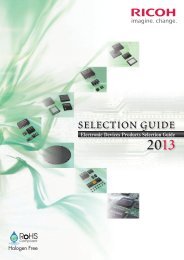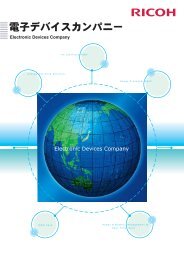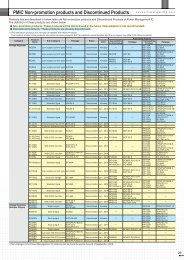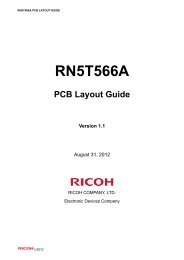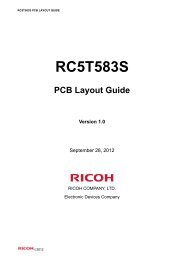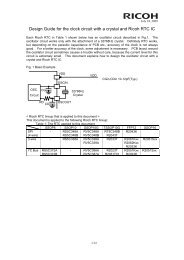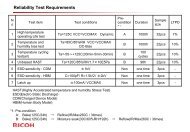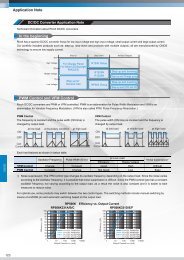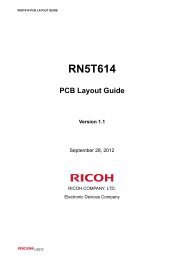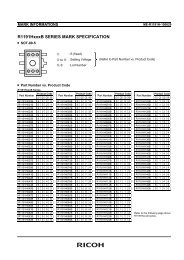Sustainable Environmental Management - Ricoh
Sustainable Environmental Management - Ricoh
Sustainable Environmental Management - Ricoh
You also want an ePaper? Increase the reach of your titles
YUMPU automatically turns print PDFs into web optimized ePapers that Google loves.
Top Message About us Our Activities<br />
Data<br />
<strong>Sustainable</strong> <strong>Environmental</strong> <strong>Management</strong><br />
F<br />
ocus<br />
IPM-based green space management:<br />
An initiative to conserve biodiversity of office premises<br />
Reducing the use of pesticides to less than 1% of<br />
the previous year’s level in the green spaces at<br />
<strong>Ricoh</strong> Ohmori Office<br />
At the <strong>Ricoh</strong> Group’s office and factories around the world, green<br />
space and greenery constitute an important part of these business<br />
sites. Some locations even have lush green forests within their<br />
premises. To conserve the biodiversity of such natural environments<br />
within our properties, the current <strong>Environmental</strong> Action Plan,<br />
effective for three years from April 2011, calls for: (1) maintenance of<br />
greenery coverage rates, (2) removal of invasive alien species, and (3)<br />
minimal use of chemical pesticides and fertilizers.<br />
To recover the health of the ecosystems on our premises and<br />
in neighboring areas, the <strong>Ricoh</strong> Ohmori Office in Japan started to<br />
manage the green space on the premises under the approach of<br />
integrated pest management (IPM)*, a comprehensive approach to<br />
pest and weed management with minimal use of chemicals, in 2010.<br />
Collaborating with GREEN WISE, a green management company,<br />
the Ohmori Office implemented IPM-based pest control measures,<br />
including physical removal, use of microbe-based pesticides,<br />
reviewing and changing where necessary the timing of carrying out<br />
pruning activities and the layout and types of greenery planted,<br />
Periodical monitoring<br />
and the conduction of periodical monitoring, along with other<br />
necessary actions. As a result, pesticide usage at the office was<br />
reduced to less than 0.17% of the previous year’s level. In 2012,<br />
other offices and plants in and outside of Japan also introduced the<br />
IPM approach into their green space management initiatives to help<br />
conserve biodiversity in their respective regions.<br />
* Integrated pest management: An integrated approach for pest and weed control, which<br />
has been internationally adopted in agricultural operations in recent years. IPM adopts<br />
an optimal combination of pest and weed prevention and control means based on the<br />
consideration of every possible technique available. It aims to reduce the use of pesticides<br />
and other chemicals to minimal levels while at the same time preventing the proliferation<br />
and growth of pests and weeds and reducing and minimizing hazards to human health and<br />
the environment.<br />
Major IPM components include:<br />
• Physical control: Using light, sound, heat and mechanical methods;<br />
• Chemical control: Applying chemicals derived from natural ingredients;<br />
• Biological control: Introducing natural enemies of target pests; and<br />
• Cultivation control: Improving the quality of soil (e.g. enhancing drainage and ventilation)<br />
Conservation of forest ecosystems<br />
Among various ecosystems, the <strong>Ricoh</strong> Group focuses particularly on forest ecosystems with rich biodiversity. We started forest ecosystem conservation<br />
projects in fiscal 2000 and now promote such projects in six countries and seven regions around the world. In these projects, we work to develop a<br />
society where local residents can maintain harmonious relationships with the forests in which they live and depend upon.<br />
■ <strong>Ricoh</strong>’s forest ecosystem conservation projects (As of the end of March 2012)<br />
Start date Country Project name/NGO partner<br />
Nov. 2001<br />
Nov. 2001<br />
Mar. 2002<br />
May 2004<br />
Japan<br />
Japan<br />
Ghana<br />
Russia<br />
Nagano Kurohime Afan Forest Conservation/<br />
C. W. Nicol Afan Forest Foundation<br />
Conservation of the Yanbaru Forest in Okinawa/<br />
Yanbaru Forest Trust<br />
Restoration of tropical rain forests/Conservation<br />
International<br />
Conservation of Taiga, the northern limit habitat of<br />
tigers/Friends of the Earth Japan (FoE Japan)<br />
Aug. 2007<br />
Aug. 2007<br />
Jul. 2011<br />
China<br />
Brazil<br />
Malaysia<br />
Conservation of biodiversity at the Three Parallel Rivers,<br />
a World Heritage Site/Asia Green-Culture Association<br />
Restoration of forests in Boa Nova, lowland tropical<br />
forests along the Atlantic coast/BirdLife International<br />
Asia Division<br />
Revitalization of mangrove forests on the north-central<br />
Selangor coast/Birdlife International Asia Division<br />
For the details on the projects WEB www.ricoh.com/environment/biodiversity/forest_ecosystem/01_01.html<br />
Project for revitalization of mangrove forests on the north-central<br />
Selangor coast in Malaysia<br />
Mangrove forests comprise a distinctive ecosystem that features the rich biodiversity of<br />
Malaysia. However, such forests are diminishing year by year as a result of illegal logging.<br />
The aim of this project is to share recognition of the importance of this forest ecosystem<br />
with the local residents and to achieve revitalization and sustainable conservation of<br />
such forests through environmental education and tree planting activities.<br />
<strong>Ricoh</strong> Group Biodiversity Policy<br />
WEB<br />
www.ricoh.com/environment/management/principle2.html<br />
<strong>Ricoh</strong> Group Sustainability Report 2012 74



